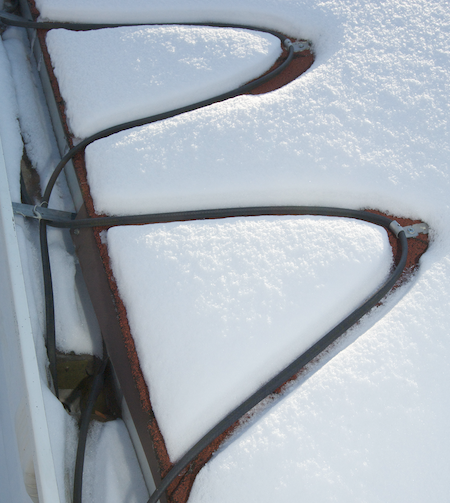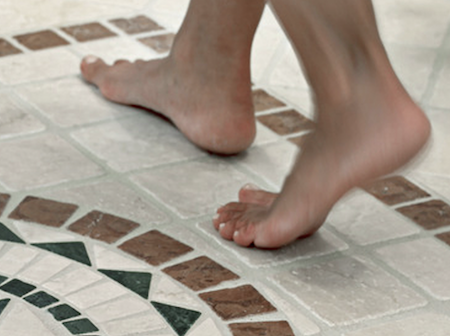Warming up to electrical heating cables
Today’s heating cables are safe, energy-efficient solutions to taking off winter’s chill.
by Peter K. Leal, Product Marketing Manager, Emerson
 |
| Self-Regulating heating cables are designed to vary heat output as the surrounding temperature changes. They are ideal for use on metal or plastic water supply and drain pipe applications that are subject to freezing temperatures, for processing applications where piped liquids require a constant temperature, and as freeze protection for branch sprinkler systems. |
 |
| The proven solution to roof and gutter de-icing are heating cables. By preventing ice dam formation along roof edges, in gutters, drains and downspouts, the cables create a path for melted water off the roof that prevents ice dams from forming. An automatic controller, included with most systems, makes operation more energy efficient. |
 |
| Heating cables can be installed underneath concrete or asphalt driveways, sidewalks or patios to fight off snow or ice. This is a much more efficient and “green” alternative to shoveling or applying environmentally harmful salt. Formed into mats of varying sizes, the heating cable system is applied underneath the concrete or asphalt surface area or pavers. |
 |
|
Hardwood and tile floors can feel uncomfortably cold even in warm climates. Under floor warming cables remove the chill with gentle, continuous warmth when used as supplemental heat to make the floor cozy or as space heat to warm an entire room. Depending on the manufacturer, systems can be used with numerous choices in surfaces including ceramic, porcelain, terrazzo, glass mosaic, marble, and natural stone and agglomerates, as well as under the engineered wood and laminated. |
Heating cables are commonly referred to as heat trace cables, heat tracing, or heat tape, while the most advanced cable design, self-regulating heating cables, are also known as self-limiting cables.
Whatever they are called, all work largely on the same principle: when voltage is applied across a length of wire of a given resistance, it then dissipates a fixed level of power in the form of radiating heat based on ohms law. Heat is emitted due to the resistance in the cable alloys as the current moves through it, thereby warming up the immediate physical surroundings.
For that reason, heating cables are used in a multitude of applications, from pipe freeze protection, to snow melting on a sidewalk or driveway, to preventing ice dams on roofs, to keeping dangerous icicles from forming in gutters and downspouts, to indoors floor warming when installed under tiles or hardwood floors.
In addition, heating cables are used in a range of industrial freeze protection and process maintenance applications to keep liquids in pipes at a constant temperature to prevent degradation of the liquid or to maintain viscosity for flow conditions. Industrial heating cables will not be addressed in this article.
There are two basic types of heating cables:
• Constant Wattage Heating Cables are the most basic of the two. These types of fixed length cables are either on at full 100% heat output or off at 0% heat output. They usually require a thermostat to maintain a constant temperature. Constant wattage cable cannot be overlapped, as this could cause them to overheat. A break in a section of cable will cause a complete failure of the entire system.
They offer the advantage of being inexpensive but cannot be cut on-site. Instead, they are sold in specific lengths and wattage outputs, making them less versatile than self-regulating cables.
Constant wattage cable can be used on indoor and outdoor water supply lines that are subject to freezing temperatures. They are ideal for use in crawlspaces, cottages, barns and outbuildings that are not regularly heated.
• Self-Regulating heating cables overcome the constrictions of constant wattage cables. In this type of cable, the electrical power wires are co-extruded into a heating element consisting of a polymer-based material with carbon particles. This provides a resistance path, hence a circuit along the length of the heating cable. This resistance and therefore the output of the heating cable varies depending upon the temperature due to microscopic expansion and contraction of the polymer.
Power output is reduced as temperature increases. Conversely, at lower temperatures, the power is increased. No thermostat is required because they automatically vary their heat output based on changes in the surrounding temperature. Designed for industrial, commercial and residential applications, they deliver maximum freeze protection and temperature maintenance plus can be cut to any length on-site quickly and easily.
Because they are designed to vary heat output as the surrounding temperature changes, they are ideal for use on metal or plastic water supply and drain pipe applications that are subject to freezing temperatures, for processing applications where piped liquids require a constant temperature, and as freeze protection for branch sprinkler systems.
PIPE PROTECTION WITH HEATING CABLES
Consider this: a gallon of water, when frozen, will expand to a volume 9% greater than the original gallon. So it is no surprise that a fully or partially frozen pipe will swell up and crack, in particular when there is trapped air in the pipe.
A bulge or crack in a pipe with ice seeping out is a clear indication of a burst pipe. Occasionally, however, the pipe may look fine and a homeowner may not see the small fractures caused by ice expansion.
Unfortunately, once the ice inside a frozen pipe begins to melt and water seeps out, it is already too late. Depending on the extent of the damage, total cleanup costs from a busted pipe can soar to tens of thousands of dollars. State Farm Insurance estimates the average insurance claim for water damage from frozen pipes is approximately $15,000.
If a building owner knows that a certain part of a structure with active water pipes may experience temperatures below freezing, the smart solution is to install a heating cable. When combined with an integrated thermostat, the system is automatically turned “on” when temperatures drop below freezing. The cables provide the needed level of heat to keep the pipes from freezing but not enough to heat the water inside of the pipes.
The thermostat provides automatic control of the system so it saves energy by powering the cable only when required. For optimal performance of the system, pipe insulation can be installed over the cable to help retain heat, and plastic pipes can be wrapped in aluminum foil so the heat is dissipated evenly in the pipe.
The benefit of this design is that the cables are installed once and left mounted on pipes for years — even when temperatures drop as low as -40°F (-40°C).
PREVENTING ICE DAMS WITH HEATING CABLES
An ice dam is a formation of ice that appears at the eaves of a roof during extended periods of snow and cold weather. Ice dams form when ice builds up along the edge of the roof, creating a dam that traps water in a pool. If a large enough amount of water collects, it can force its way in underneath the roof shingles and all the way into a building, causing extensive damage to ceilings, floors and behind walls.
Repairing a roof is expensive. Even a minor repair as small as a couple square feet typically costs $1,000 or more. Larger repairs, or slate and metal roof repairs, can costs thousands more. A complete re-roof, meaning tearing off the old roof from the house and replacing it with a new one, can range in cost from $4,000 up to $25,000.
Again, the proven solution to roof and gutter de-icing are heating cables. By preventing ice dam formation along roof edges, in gutters, drains and downspouts, the cables create a path for melted water off the roof that prevents ice dams from forming. An automatic controller, included with most systems, makes operation more energy efficient.
By connecting the controller between the electric outlet and the cable, the controller will turn the system “on” when temperatures are below 38°F (3°C) and there is a presence of water on the sensor’s surface. If only one of the above-mentioned conditions exists the control will not turn “on” the system. When a temperature rises above 48°F (9°C) the controller turns the system off.
SNOWMELTING WITH HEATING CABLES
Heating cables can be installed underneath concrete or asphalt driveways, sidewalks or patios to fight off snow or ice. This is a much more efficient and “green” alternative to shoveling or applying environmentally harmful salt. Formed into mats of varying sizes, the heating cable system is applied underneath the concrete or asphalt surface area or pavers. The mats are extremely cost effective and eliminate the expensive, labor-intensive hassles of snow removal by automatically maintaining a surface temperature above freezing.
Two conditions must be present concurrently for the mats to activate: the temperature must be freezing and the system must detect moisture or snowfall. Even in northern cities like Chicago, the actual time of snowfall onto the ground is under 30 hours per year. From a cost standpoint, that translates to just a few dollars a year. It also means no more calling costly snowplow services that can range into hundreds or even thousands of dollars per year. Plus, if it snows in the middle of the night, you will wake up to an already cleared sidewalk and driveway – unlike your neighbors.
Another less obvious advantage is that the mats are noiseless. Anyone who has had to listen to a snow blower operating for hours on end can attest to it being a less-than-pleasant experience.
In most cases, snow will melt at a rate that keeps up with average snowfall, minimizing accumulation of snow on the heated surface. Depending on the voltage available and configuration, mats can easily be combined and tailored to cover a unique walk, stair, patio and driveway configuration.
Businesses and homeowners benefit from safer walkways, lower insurance rates and compliance with the Americans With Disabilities Act (sec 3.2.4.3). Loading docks, ambulance entries and passenger platforms at bus stations and train depots also benefit from this protection where pedestrians can move securely on the protected surface.
FLOOR WARMING WITH HEATING CABLES
Hardwood and tile floors can feel uncomfortably cold even in warm climates. Under floor warming cables remove the chill with gentle, continuous warmth when used as supplemental heat to make the floor cozy or as space heat to warm an entire room.
Depending on the manufacturer, systems can be used with numerous choices in surfaces including ceramic, porcelain, terrazzo, glass mosaic, marble, and natural stone and agglomerates, as well as under the engineered wood and laminated.
Cables can even be installed in tiled showers or other wet areas, although it is recommended that the homeowner check with their local electrical inspector first to verify that this application is allowed in the jurisdiction.
Besides comfort, floor-warming systems are safe, energy-efficient and economical. Once installed, it’s nearly impossible to damage or cut the cables. In addition, a GFCI-protected programmable thermostat will instantly cut power in the event of a short. The thermostat also offers precise temperature control, monitoring and regulating the floor temperature to provide the optimal warmth.
Cost is minimal: at 12 watts per square foot, a 30-sq.-ft. mat draws the equivalent of an electric blanket. Plus, it is estimated that adding floor warming throughout a home can increase its resale value by as much as four percent.
Modern floor warming systems are manufactured as either “free form” cables that provide maximum design versatility, or in “fixed” cable mats for labor savings in standard shaped rooms. Free form cables are loose, so they can be turned and positioned in any pattern to fit areas with curves, angles or obstacles. Cable spacing is not fixed and it is recommended that a 2-3 inch gap be maintained between them.
It is also highly recommended to create a “buffer” area on the floor plan, where heating is not essential and which can be used to run leftover cable. While it is common practice, duct tape is not recommended for securing cables since it does not guarantee proper spacing and may result in insufficient or leftover cable length and uneven heat output. Instead, free form cables should be installed using clips or uncoupling membranes directly onto the subfloor structure, and are then embedded in thin-set or self-leveling underlayment.
Unlike free form cables, fixed or pre-fabricated radiant heated mats feature heating cables interwoven into a mesh backing that is suited for fast installation in standard rectangular areas, multi-unit applications, or expansive rooms. While the backing can be cut to allow for some layout customization, the cables themselves must remain intact, limiting design flexibility. In installations where trimming the backing isn’t enough, custom mats can be ordered from the manufacturer in various shapes such as ovals, circles and triangles.
As you would expect, fixed cable installation is a faster, less labor-intensive process than free form cables. Self-Adhesive Mats floor warming systems are even easier. The mats are commercially available in standard sizes of pre-fabricated rectangular mats with a self-adhesive, wide-spaced backing to help reduce installation time and labor. The mats can be placed on the substrate and will stay put while the mat is embedded in thin-set or self-leveling underlayment.
At less than 1/8 inch thick, the mats result in virtually no floor height buildup, significantly reducing retrofit costs since door or trim work does not need to be raised. CS
Peter K. Leal, is Product Marketing Manager for Emerson, and has been with Emerson for 8 years. He has responsibility for all EasyHeat branded products, which includes heating cables and thermostats. His degree is in Industrial Engineering and has over 20+ year experience in product management and new product development, along with 10+ years experience in the consumer/retail market.
Learn more at www.emerson.com/en-us/commercial-residential/heating-and-air-conditioning/heating-cable-indoor-outdoor
















